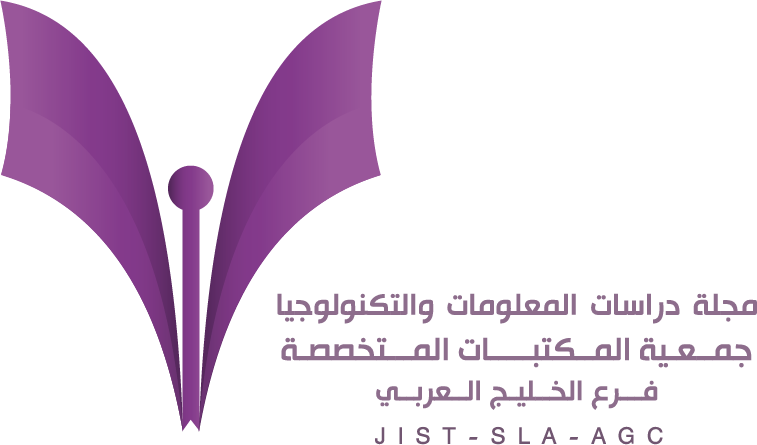- Home
- A-Z Publications
- Journal of Information Studies & Technology (JIS&T)
- Previous Issues
- Volume 2023, Issue 1
Journal of Information Studies & Technology (JIS&T) - Volume 2023, Issue 1
Volume 2023, Issue 1
- Editorial
- Research Article
-
-
تطبيق منهجية الستة سيجما في أقسام المكتبات وعلم المعلومات في جامعات المملكة العربية السعودية: دراسة تحليلية
More Lessملخص هدفت الدراسة إلى تحديد مدى تطبيق مبادئ منهجية الستة سيجما في أقسام المكتبات وعلم المعلومات من وجهة نظر أعضاء هيئة التدريس، ومعرفة أهم متطلبات تطبيق الستة سيجما، كذلك التعرف المعوقات في حالة تطبيق الستة سيجما، قد تم استخدام المنهج المسحي الوصفي، واعتماد أداة القياس الرئيسة الاستبانة، مع اختيار عينة الدراسة المكونة من 165 عضو هيئة تدريس بأقسام المكتبات وعلم المعلومات في جامعات المملكة العربية السعودية. وقد توصلت الدراسة إلى أن هناك موافقة بد Read More -
نضج إدارة البيانات الرئيسية في المؤسسات الحكومية: دراسة حالة لوزارة النقل والخدمات اللوجستية
More LessAuthors: أروى نصار الميلبي and هناء علي الضحويملخص تستمد الدراسة الحالية أهميتها من منطلق أن البيانات بشكل عام تعد عنصرًا مهمًّا في كل مؤسسة، وركيزة أساسية في اتخاذ القرارات، بالإضافة إلى الدور الذي يقوم به كلٌّ من البعد التنظيمي والتكنولوجي والإداري في تحسين جودة البيانات الرئيسة. وتهدف الدراسة إلى التعرف على الأبعاد الثلاثة (الإدارية – التقنية – البشرية) التي تؤثر في نضج إدارة البيانات الرئيسة في المؤسسات الحكومية بشكل عام، ووزارة النقل والخدمات اللوجستية بشكل خاص، وبناء على ذلك اعتمدت الدراسة على منهج تحليل الم Read More -
سلوك التعامل مع المعلومات الخاطئة على منصات التواصل الاجتماعي لدى المجتمع العماني خلال أزمة كورونا
More Lessملخص هدفتِ الدراسة إلى التعرف على سلوك المُجتمع العُمَاني في التعامل مع المعلومات الخاطئة المتداولة على منصات التواصل الاجتماعي أثناء جائحة كورونا، وتأثيرها على استجابة الحكومة للجائحة. اعتمدت الدراسة على المنهج المسحي الكَمِّي، وتم جمع بياناتها بواسطة استبانة مُحكمة. تم اختيار 15 مجموعة في تطبيق الواتساب مرتبطة بمجالات وموضوعات متنوعة لتمثل عينة الدراسة؛ وقد وُضع في الاعتبار التنوع الجغرافي والموضوعي والنوعي للمجموعات. وزعتِ الاستبانة إلكترونياً من فبراير 2022م إل Read More -
الدور الفعال للبيانات الضخمة في دعم قطاع الاتصالات: دراسة تحليلية
More LessAuthors: سلمه سالم البلادي and فتون أحمد عثمانملخص في عصر التطور التقني الذي نعيشه اليوم، تعمل تقنيات الحوسبة السحابية ووسائل التواصل الاجتماعي وتقنيات الاتصالات المتنقلة والحوسبة الرقمية إلى جانب عدد متزايد من المعاملات على تعزيز نمو البيانات. وتم تصميم تقنيات البيانات الضخمة لاستخلاص قيمة اقتصادية من أحجام ضخمة من البيانات المختلفة والمتنوعة، وذلك من خلال تمكين الاستحواذ على البيانات بسرعة عالية واكتشافها و/أو تحليلها، ويتم تطبيق هذه التقنيات في كافة القطاعات. فالدراسة الحالية تهدف إلى إلقاء الضوء على تقن Read More -
التحديات التي تواجه المكتبات الأردنية في مجال الأرشفة الإلكترونية من وجهة نظر أعضاء جمعية المكتبات والمعلومات الأردنية
More LessAuthors: ربحي مصطفى عليان, هدى زيدان عباس and مها وليد الفاضلملخص هدفت الدراسة إلى التعرف على التحديات التي تواجه المكتبات الأردنية في مجال الأرشفة الإلكترونية من وجهة نظر أعضاء جمعية المكتبات والمعلومات الأردنية. وقد تكونت عينة الدراسة من 83 فرداً استجابوا لأداة الدراسة، ولديهم الخبرة في مجال الأرشفة الإلكترونية. ولتحقيق أهداف الدراسة اعتمدت الدراسة على المنهج الوصفي المسحي، حيث طورت استبانة تكونت من قسمين رئيسيين، الأول شمل البيانات الديموغرافية عن أفراد عينة الدراسة وهي: الجنس، والخبرة، والمؤهل العلمي، ونوع المكتبة، Read More -
التقنيات الحديثة في خدمة النص القرآني: دراسة مقارنة لتطبيقات غريب القرآن الكريم
More Lessملخص ركزت الدراسة على تقييم وتحليل تطبيقات غريب القرآن، واشتملت على 34 تطبيقاً من خلال: رصد المسؤولية، ودراسة عناوينها، وتحديد سعتها، وإيضاح نظم ترتيبها، وتحليل حجم وعناصر مادتها المرجعية، والمقارنة بين إمكاناتها البحثية والاسترجاعية، وتحديد عدد تنزيلاتها، وتقييمها من وجهة نظر المستفيدين. واستخدمت الدراسة منهج تحليل المحتوى. وقد أسفرت عن الكثير من النتائج، من أهمها أن أكثر التطبيقات استخدمت في عناوينها لفظ "غريب"، وبلغت نسبتها 32.5%، تلاه "كلمات القرآن" بنسبة Read More
-
Volumes & issues
Most Read This Month
Article
content/journals/jist
Journal
10
5
true
en


